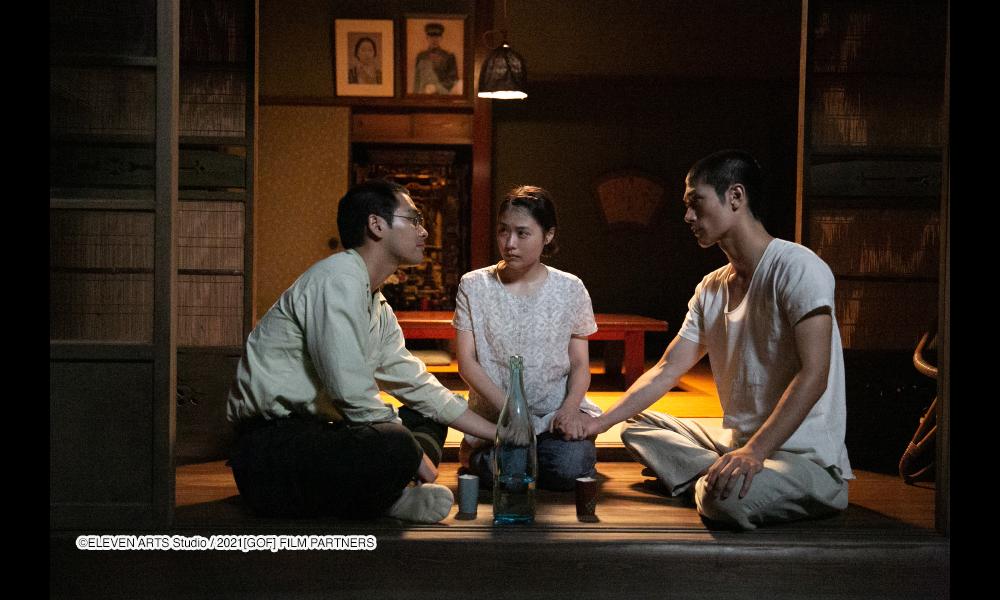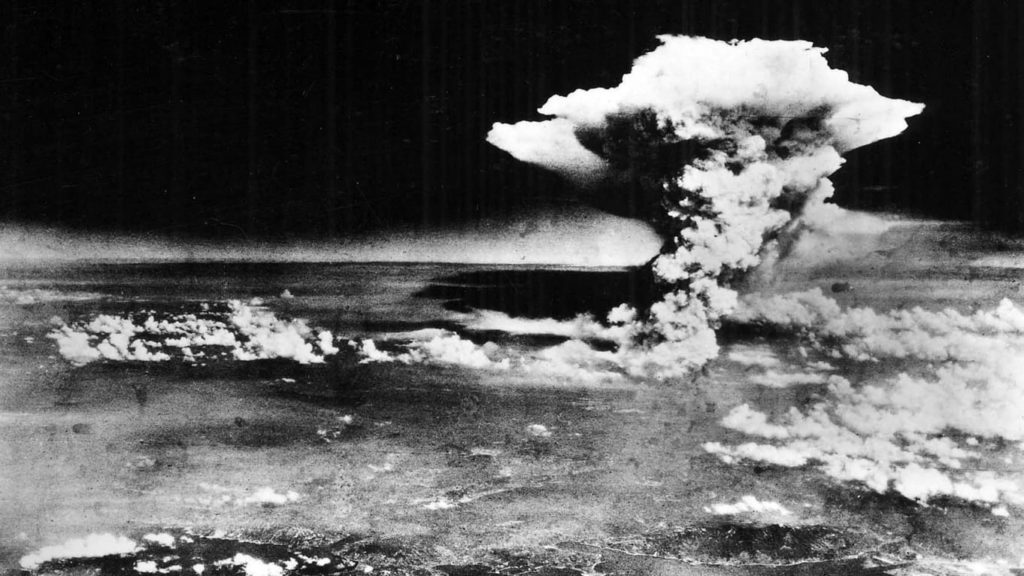Editor note: Japan had two different military programs working on developing an atomic bomb. The movie reviewed here only discusses one of the programs. Japan’s attempt to develop nuclear weapons was much more successful than imagined, click here and read What If Japan Had the Atomic Bomb First? For more details.
Review by Kaori Shoji
“Gift of Fire (Japanese original title: Taiyo no Ko)” proffers an unsettling view from an old and familiar window. Directed by Hiroshi Kurosaki, the gist of this story set in the summer of 1945, is this: just weeks before Japan’s surrender in WWII, a team of graduate students at Kyoto University were hard at work on the creation of a nuclear bomb. While this piece of information may not be news to many western historians, the majority of the Japanese are bound to feel baffled. For generations, the Japanese were conditioned – by our elders, by the media, by the education system and history itself, to feel that we were the victims of a war that very few in the populace ever wanted to fight. And now a Japanese movie is saying we could have been the perpetrators of the world’s first nuclear bomb attack? That’s an incredibly heavy load to process, and still more to confront.

After all, Japan had banked the struggle of the postwar years and the rapid growth era that followed it, on Hiroshima and Nagasaki. The horrors that happened on August 6th, 1945 in Hiroshima and then, a mere 72 hours later in Nagasaki, were recounted through generations and revived in the media more times than anyone could count. It was a legacy of suffering, a collective mantle of unspeakable sadness under which the Japanese toiled and labored for decades to come.
At the same time, the two bombs exonerated the Japanese from having to explain and face up to wartime atrocities – the crimes committed in Korea, China, Singapore and pretty much the entire Asian Pacific Rim. Call it the a-bomb card, pulled out when the Koreans or Chinese got noisy about acknowledgement and reparations for war crimes. And whenever the Japanese people protested against the econo-centric measures of the government that irredeemably polluted oceans and mountains and quashed the livelihoods of millions of traditional workers. For seventy plus years, the a-bomb card served Japanese politicians, their politics and the national conscience. We suffered enough, now leave us alone.
But “Gift of Fire” says it may be about time to turn in that card.

The Kyoto University lab was under close scrutiny by the Imperial Army and the scientists were pressed for results. If and when they succeeded in splitting the atom, the plan was to drop the bomb on San Francisco. The students were plagued by doubts and filled with anxiety, and who can blame them. Nightly air raids, frequent power outages and utter lack of resources prevented their experiments from moving forward when all the while, they were listening to American news on a hand-crafted short wave radio. The Americans were closing in on the Japanese Imperial Army though the propaganda reports from the frontlines said otherwise. “Should we even be doing this, in the comfort of a laboratory? Shouldn’t we be fighting and giving our lives to this country?” says one anguished student, who eventually quits the project to enlist in the Imperial Army.
The truth was, the Kyoto University team lacked everything to build anything, let alone a weapon of mass destruction. Still, they forge on, fueled by a blind hope that an atomic bomb will change the course of the war or even end it. Besides, says Professor Arakatsu, the helmer of the project: “if we don’t build it the Americans will. And if the Americans don’t get there first the Soviets will. Why do you think this war started in the first place? It’s because the world is in a race to procure energy resources. Whoever gets control of the energy, gains control over the world.”
By saying that, Arakatsu has shifted the concept of war from ideology and nationalism to science and technology. Fittingly, “Gift of Fire” is mostly devoid of sentiment and righteousness, preferring instead to sanctify the scientist and all that he stands for. In Arakatsu’s laboratory, scientific advancement is a religion, and the god at the altar is Albert Einstein. The highest prayer of course, is E=mc2. The film marks the first time a Japanese film has addressed the atomic bomb from a scientific standpoint, and bringing in an American voice to the proceedings. Kurosaki persuaded Peter Stormare to appear in a voice-only role that defends, honors and ultimately glorifies the scientific mission.
Perhaps that voice belongs to Shu (Yuya Yagira) who is the most committed member in Arakatsu’s lab. Shu is responsible for procuring the much-needed uranium for their experiments, and turns to a local potter for his meager supply. The potter used to make beautiful things, but now he only makes funeral urns. “A lot of people dying,” says the potter matter-of-factly to Shu, pointing to the rows and rows of small white urns turned out in his kiln that day. Shu can only nod, bow and make his exit with the uranium powder stashed in his rucksack. Shu knows that Japan will hurtle toward a terrible defeat unless they can build the bomb before the Americans. At the same time he knows their chances of making that happen are practically zilch. Yet the thought of giving up never crosses his mind. A stubborn work-ethic and an obsessive regard for science dictates Shu’s actions and his MO, like the rest of his team, is to ‘ganbaru (do the best they can)’ until they drop.
Director/writer Hiroshi Kurosaki is a seasoned television director, best known for his work on the NHK morning drama series “Hiyokko, (2017)” which means ‘youngster.’ Kurosaki has a flair for portraying youth and innocence under duress. “Hiyokko” was set in the post war years, with a young female protagonist (Kasumi Arimura) searching for her missing father in Tokyo. Arimura teams up with Kurosaki again for “Gift of Fire” as she plays Setsu, who is Shu’s possible love interest. Setsu, perhaps as a nod to our times, is not the typical docile young woman of wartime Japan. In one scene she lectures Shu and his brother Hiroyuki (played by the late Haruma Miura who committed suicide last summer. The film marks his final screen appearance) about their tunnel vision, exhorting them to look beyond the war and envision a future without violence. In the post-screening press conference Kurosaki said: “I wanted to portray what a young woman must have felt in the final days before the surrender. She’s young and has an intense desire to live and experience life, but death is always there.”
“Gift of Fire” is not without redemption. What permeates the otherwise dark and spartan narrative is the sheer innocence of the characters, especially Shu and Hiroyuki. In their separate ways, the brothers seek closure to a war that had come to define their identifites – Shu by creating the atomic bomb, and Hiroyuki by flying a plane right into an American warship. Defeat may be imminent but neither of them are about to surrender peacefully. “They made mistakes, they’re not heroes,” said Kurosaki. “They are ordinary young men, blundering on and doing the best they can.” Sadly that’s never enough to right a ship gone horribly awry.
END
fatwomanin sucking partydia zerva bathtubwwwbabhi dever xnxxvideoexcellent 4k lesbians2013 public pickupsCollege lesbian rulesNepal studen sexquivering tricky massagemom hasdad
papedhot russians femdomheels mandi lahaiemilf hotel roomhuge
gangbang swalloweboots tease skirt